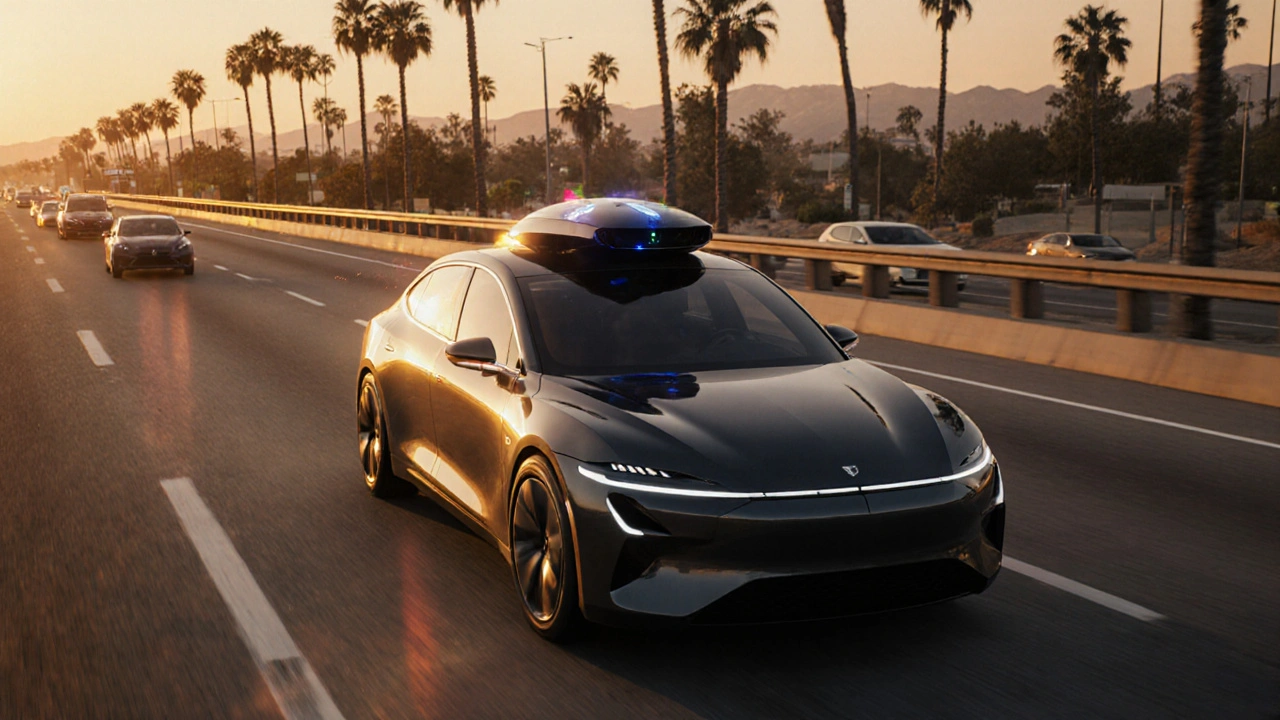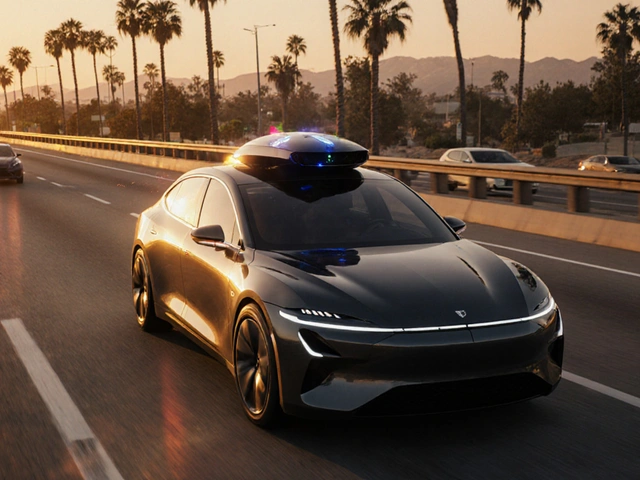AV Impact Estimator
Adjust parameters below to estimate potential travel time and congestion improvements with autonomous vehicles.
Quick Takeaways
- Self‑driving cars can cut stop‑and‑go waves, but only if they’re networked and well‑regulated.
- Without proper policy, AVs may add empty miles and worsen peak‑hour jams.
- Integration with smart traffic signals and ride‑sharing platforms is crucial for real congestion relief.
- Urban planners must redesign curb space and lane allocations to reap AV benefits.
- Early pilots in Phoenix and Helsinki show up to 15% travel‑time reductions when AVs operate at 30% market share.
Imagine cruising through a morning rush without constantly braking and accelerating. That’s the promise of autonomous vehicles self‑driving cars that use sensors, AI, and connectivity to navigate without a human behind the wheel. As cities grapple with ever‑growing traffic volumes, the question isn’t just whether these cars will arrive-it’s how they’ll reshape congestion patterns that have plagued commuters for decades.
What Makes an Autonomous Vehicle Tick?
At the core of every AV is a suite of technologies that turn raw data into motion decisions. AI navigation algorithms machine‑learning models that predict vehicle trajectories, interpret traffic rules, and optimize routes in real time process inputs from lidar, radar, and high‑definition cameras. When these cars talk to each other and to infrastructure-known as vehicle‑to‑infrastructure communication (V2I a data link that lets cars exchange signals with traffic lights, road sensors, and city servers)-they can smooth out platoons, eliminate sudden stops, and keep traffic flowing at near‑optimal speeds.
Why Congestion Happens Today
Modern traffic jams are less about road capacity and more about human behavior. Drivers often over‑react to brake lights, creating “phantom” bottlenecks. A single lane closure can ripple back for miles, a phenomenon known as shockwave traffic. Road capacity the total number of vehicles a road can safely accommodate per hour is frequently under‑utilized during off‑peak periods and overloaded during peaks, leading to uneven demand. Add in parking searches, delivery vans double‑backing, and uncoordinated ride‑hailing pickups, and the system quickly reaches its breaking point.
How AVs Could Reduce Stop‑and‑Go Waves
When a fleet of AVs travels together, they can form tightly spaced convoys, or platoons, that react uniformly to traffic signals. Using smart traffic lights signal controllers that adjust phase timing based on real‑time vehicle data, an AV platoon can request a green wave, reducing the number of stops per mile. Studies from the University of Michigan show a 20% reduction in fuel consumption when 40% of traffic is autonomous, largely thanks to smoother acceleration profiles.

Potential New Bottlenecks
However, AVs are not a silver bullet. If they are primarily used for empty re‑positioning-driving without passengers to pick up the next rider-they can add mileage that never carries cargo, a phenomenon called “deadheading.” In dense city cores where curb space is scarce, autonomous ride‑hailing fleets might dominate curbside spots, pushing delivery trucks onto already congested streets. Moreover, early‑stage mixed traffic (human‑driven plus AV) can create coordination challenges: human drivers may not trust the steady pace of AVs, leading to lane‑changing maneuvers that offset any efficiency gains.
Policy Levers That Matter
City planners have several tools to steer AVs toward congestion relief. Zoning policies can reserve dedicated AV lanes, similar to bus rapid transit corridors. Dynamic pricing of curb space-charging higher fees during peak hours-encourages AV fleets to drop passengers further from congested zones, a strategy known as “last‑mile micro‑mobility.” Integrating AV data feeds into existing traffic management centers enables urban planning the practice of designing city layouts, zoning, and transportation infrastructure to meet long‑term growth goals models, allowing officials to simulate future scenarios before committing to costly hardware.
Real‑World Pilots and Early Results
Several municipalities have already tested AV‑centric traffic strategies. Phoenix’s “AV‑First” corridor allows current‑generation self‑driving shuttles to operate with priority signaling, resulting in a reported 12% drop in average travel time on the 5‑mile stretch. Helsinki’s public‑transport agency paired autonomous buses with adaptive traffic lights, cutting stop frequency by 30% during rush hour. Meanwhile, Singapore’s Land Transport Authority is experimenting with a “mixed‑traffic” sandbox where AVs share lanes with human drivers under strict data‑sharing agreements, providing valuable insight into safety margins and flow dynamics.
Bottom Line: A Conditional Win
The impact of autonomous vehicles on future congestion hinges on three interlocking factors: technology adoption rate, data‑driven coordination with infrastructure, and proactive policy frameworks. If cities invest in V2I ecosystems, allocate curb space wisely, and curb empty‑vehicle miles, AVs could shave minutes off daily commutes and lower emissions. Conversely, unchecked growth of autonomous ride‑hailing fleets may simply shift congestion from one street to another.
| Metric | Current (Human‑Driven) | Future (30% AV Share) |
|---|---|---|
| Average Stop‑And‑Go Events per Trip | 8 | 5 |
| Travel Time Variability (minutes) | ±4 | ±2 |
| Fuel Consumption (liters/100km) | 7.5 | 6.0 |
| Empty‑Vehicle Miles (% of total) | 10% | 15% (if no routing policy) |
| Peak‑Hour Road Utilization | 95% | 85% (with coordinated signaling) |
Next Steps for Readers
- If you’re a commuter, keep an eye on local AV pilot programs-early adopters often get priority parking or discounted fares.
- Urban planners should start gathering data on V2I readiness; a simple API integration can unlock dynamic signal timing.
- Policy makers can begin drafting curb‑pricing frameworks that differentiate between passenger‑only AVs and freight‑type vehicles.
- Technology firms must prioritize algorithms that reduce deadheading by optimizing ride‑matching across neighborhoods.

Frequently Asked Questions
Will autonomous vehicles eliminate traffic jams?
Not entirely. AVs can smooth traffic flow and reduce stop‑and‑go waves, but congestion also depends on road capacity, demand spikes, and policy choices. Without coordinated signaling and curb‑management, AVs might add empty miles that offset gains.
How does vehicle‑to‑infrastructure communication help?
V2I lets AVs share their exact location, speed, and intended route with traffic lights. The lights can then adapt their phases to create green waves, cutting down the number of stops per trip and improving overall throughput.
What are the environmental benefits?
Smoother acceleration reduces fuel consumption by roughly 15‑20% in mixed traffic, lowering CO₂ emissions. However, extra empty miles can negate some of that benefit unless routing efficiency is enforced.
Are there safety concerns with mixed traffic?
Yes. Human drivers may misinterpret the steady behavior of AVs, leading to unexpected lane changes. Ongoing pilot programs emphasize clear external signaling (e.g., LED displays) and strict speed harmonization to mitigate these risks.
When can we expect noticeable changes in my city?
Major impacts usually appear after AVs capture around 30% of peak‑hour traffic and when cities have deployed adaptive traffic signals. That timeline varies, but many U.S. and European cities aim for pilot completion by 2027‑2028.



liza kemala dewi
September 30, 2025 AT 17:13The prospect of autonomous vehicles reshaping urban mobility invites a profound reflection on the nature of modern transportation. As cities continue to grapple with congestion that stems not merely from physical capacity but from the stochastic behavior of human drivers, the orderly algorithms that guide self‑driving cars present a compelling counterpoint. By eliminating the reactionary braking that propagates phantom bottlenecks, AVs can, in theory, transform stop‑and‑go waves into a fluid stream of motion. Moreover, the integration of vehicle‑to‑infrastructure communication promises to synchronize traffic signals with real‑time vehicle trajectories, thereby creating adaptive green waves. Yet, the realization of such benefits depends upon a confluence of technological maturity, regulatory foresight, and societal willingness to cede control. Without a cohesive policy framework that limits empty‑miles and incentivizes shared mobility, the very flexibility of autonomous fleets may generate additional mileage that nullifies efficiency gains. Empirical evidence from pilot programs in Phoenix and Helsinki indicates that modest market shares-around thirty percent-can already deliver measurable reductions in travel time variability. These case studies underscore the importance of embedding AVs within a broader ecosystem of smart traffic management rather than treating them as isolated curiosities. From an environmental perspective, smoother acceleration profiles translate into lower fuel consumption and diminished emissions, aligning with climate objectives. Nevertheless, the specter of increased curbside competition for ride‑hailing services raises concerns about unintended spillover effects on delivery logistics. Urban planners must therefore anticipate the spatial reallocation of curb space, perhaps by designating dedicated lanes or dynamic pricing zones for autonomous fleets. The philosophical implication is that technology alone cannot resolve congestion; it must be coupled with intentional urban design. In this sense, autonomous vehicles serve as both tool and catalyst, urging municipalities to rethink zoning, lane allocation, and multimodal integration. Should cities invest wisely in V2I infrastructure and adopt policies that discourage deadheading, the net societal gain could be significant. Conversely, neglecting these complementary measures may result in a scenario where autonomous vehicles merely shift congestion from one artery to another, thereby preserving the status quo.
Jay Jonas
October 10, 2025 AT 19:37Yo, I totally vibe with the idea that AVs could smooth out traffic, but man, the drama of deadheading still haunts me-definatly need smarter dispatch or we'll just be cruising empty.
Liam Warren
October 20, 2025 AT 22:01From a systems‑engineering perspective, the throughput gains hinge on high‑density platooning coupled with low‑latency V2I protocols; when you align signal phase timing with the platoon’s arrival, you effectively create a moving bottleneck‑free corridor. In practice, this translates to a reduction in stop‑and‑go cycles by up to 40 % in mixed‑traffic simulations. However, the scaling factor is sensitive to the market penetration rate-below the 20 % threshold, the stochastic interference from human drivers dominates the flow dynamics.
Dominique Lemieux
October 31, 2025 AT 00:25While the hype machine chants about "smooth traffic", the reality could be that autonomous fleets become the new traffic sharks, gobbling up curb space and spawning a fresh breed of congestion that looks exactly like the old one, only with slicker chassis. If you let a legion of empty‑miles‑only robo‑cabs roam the city without strict routing policies, you’ll end up with more miles logged and the same, if not worse, gridlock.
Laura MacEachern
November 10, 2025 AT 02:49That’s a fair point, but there’s also a bright side: cities can turn the challenge into an opportunity by allocating dedicated AV lanes and using dynamic curb pricing to keep the streets flowing. When municipalities pair these policies with real‑time data sharing, the net effect can be a noticeable dip in average commute times, even if the fleet isn’t 100 % autonomous yet.
BJ Anderson
November 20, 2025 AT 05:13The drama of the debate often overshadows a balanced view-yes, autonomous vehicles bring efficiency, but only when the surrounding infrastructure plays along. Overlooking the human factor leads to a skewed picture where technology is blamed for any lingering jams.
Alexander Rodriguez
November 30, 2025 AT 07:37In simple terms, if the city builds smart lights and limits empty trips, the roads will get less crowded. If not, they stay the same.